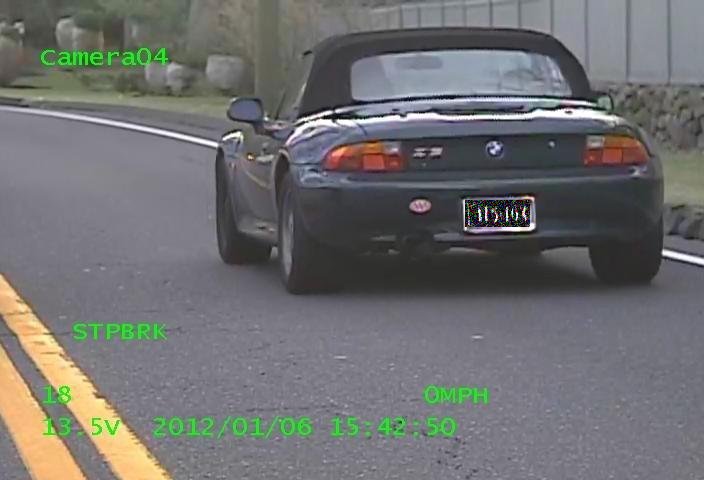ComComm LLC
Safebus Video Systems
Fleet Vehicle Upfitters - Electronics Installations Specialized Contractor
Video, GPS, Alarms, Two-way radios & Wireless data for the Mobility Industry
Safebus Video Systems
Serving The New England Area
NY LLC - NJ FLC
Fishkill, NY 12524
ph: 845-234-1954
fax: 845-231-6767
Knowledge is Power
Proud to Make a Difference
Effective January 1st 2012, Connecticut State law ammendment PA-11-255 allowed video evidence to be used by law enforcement to issue a $450 fine to the owner of any vehicle passing a stopped school bus.
Safebus Video Systems was there.

On January 6th, 2012, this image was captured by one of our SEON camera installations (license purposely blurred) and became one of the first violations issued by the State under the new provision.

NY is the latest State poised to pass law concerning the deployment of Stop Arm Cameras on school buses.
NY State School Bus Safety Act
Pupil Transportation reports indicate a stagering 70,000 stop arm violations accross the country each day, 10,000 per day just in NY state alone. Since 2006 the National Highway Traffic Safety Administration has listed an average of 10 fatalities per year as a direct result of students being struck by passing motor vehicles after exiting or attempting to board a school bus.
Responding to Changing Times
Increasing numbers of school bus fleets are installing onboard video and audio recording systems. It is a rapidly evolving technology, focused of course on protecting the passengers entrusted to your care while meeting many unique budgetary and purchasing requirements as well as needs and specifications of school safety boards and transportation providers. Where once only VHS tape recorders were the standard, there are now many manufacturers of different products.
All makes of DVRs share common technology;
- Hard drive or Solid State recording media (or both in some cases).
- Composite or Digital Camera Systems.
- Internal and External cameras of various lenses for specific views.
- GPS for location and speed monitoring
VHS tape recorders have been discontinued by all manufacturers.
Hard drive recorders offer the most storage capacity of any option. A typical hard drive can store up to several weeks worth of bus runs. Because of the huge capacity of these drives, recorder manufacturers can employ video formats that provide extremely high video quality as well as multiple video signals allowing for the simultaneous recording from more than one camera. Industry advances have made Hard Drive Recorders an extremely reliable standard for mobile recording however, Hard Drives are not extremely tolerant of heat, cold or vibration. A careful look at any manufactures spec sheet will show certain limitations. Currently, many recorders have built-in heat yielding devices to warm up hard drives when temperatures drop below freezing to ensure reliable recording. Some manufactures simply disable recording until the hard drive achieves a certain temperature, usually 32 degrees F.
Solid State Recorders consist of SD card based DVRs or Solid State Drives. Neither solution has the storage capacity of a Hard Drive but SD card based DVRs have become quite popular due to a typically lower cost than the hard drive systems. While the reliability of SD cards may be somewhat better in extreme conditions, overall reliability and failure rates of SD cards are in some cases worse than Hard Drives. Solid State Drives and Static Modules on the other hand, while still having less storage capacity than Hard Drives and about the same cost as the Hard Drive Systems, have shown better reliability and less failures than SD Cards and are less susceptible to vibration, dust, temperature and moisture than a Hard Drive.
It is common for “High End” DVRs to utilize an SD card buffer/back up in their Hard Drive DVR systems to help eliminate video gaps and recording failures.
Cameras in the mobile environment typically have a fixed lens configured for a specific view. With advancements in the amounts of storage capacity available to mobile DVRs, Digital HD cameras are becoming a standard option on most systems. All manufacturers offer various multiple camera configurations. Various wide and narrow angle options for different bus lengths and viewing requirements as well as outdoor cameras for viewing passing motorists. Cameras can be mounted in various locations in a bus to accommodate specific concerns. Standard cameras automatically switch to infra red night vision during low light situations.
Integrated GPS has become a standard option on most DVR systems and is used to show the vehicle location when viewing the video as well as track vehicle speed. Most manufacturers offer live GPS services that allow users to view and track vehicle locations in real time.
The bottom line is all these devices are designed to meet the same needs and goals. Specific requirements will define the type of equipment and options necessary. Most school and pupil transportation providers enlist video recording for the following reasons;
- Deter bullying, vandalism, and other offenses
- Reinforce driver accountability
- Document chain of events
- Substantiate or refute claims
- External stop arm activated video of passing motorists.
To accomplish these tasks the industry has set options and standards that again, are not confined to any single manufacturer. All mobile recording devices employ an industry standard vehicle interface to allow certain status messages to be displayed during the viewing of the video recording. These status messages include: Time, Date, Bus Number, Ignition on/off, Amber lights indicator, Stop Arm indicator, Brake indicator and Turn Signal. In Addition, Door Open and Wheel Chair Lift Deployed are typically monitored when utilizing Live GPS systems.
All manufactures allow for audio recording although there are certain legal stipulations involving audio recording in particular situations.
Any combination of these different options will aid in addressing different concerns on board a bus. Systems can be configured to address particular priorities and concerns.
Safebus Video Systems
Serving The New England Area
NY LLC - NJ FLC
Fishkill, NY 12524
ph: 845-234-1954
fax: 845-231-6767
